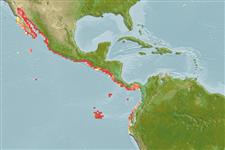Environment: milieu / climate zone / distribuzione batimetrica / distribution range
Ecologia
marino demersale; distribuzione batimetrica 1 - 100 m (Ref. 96339). Tropical; 32°N - 7°S, 115°W - 78°W (Ref. 114953)
Eastern Pacific: Gulf of California to northern Peru.
Size / Peso / Age
Maturità: Lm ? range ? - ? cm
Max length : 119 cm TL maschio/sesso non determinato; (Ref. 111131)
Found in shallow water on sandy bottoms, sometimes adjacent to reefs (Ref. 12951). Found buried in the sand during the day (Ref. 12951). Moves into shallow bays at night to feed; prefers polychaete worms, but may take sea squirts (Ref. 12951). Produces litters of up to 15 pups. Maturity size of males at ca. 36 cm TL; birth size at ca. 11 cm TL (Ref. 114953).
Life cycle and mating behavior
Maturità | Riproduzione | Deposizione | Uova | Fecundity | Larve
McEachran, J.D., 1995. Narcinidae. Rayas eléctricas. p. 769-771. In W. Fischer, F. Krupp, W. Schneider, C. Sommer, K.E. Carpenter and V. Niem (eds.) Guia FAO para Identification de Especies para los Fines de la Pesca. Pacifico Centro-Oriental. 3 Vols. FAO, Rome. (Ref. 9259)
IUCN Red List Status (Ref. 130435: Version 2025-1)
Human uses
Strumenti
Special reports
Download XML
Fonti Internet
Estimates based on models
Preferred temperature (Fonte Biblio.
123201): 18.5 - 28.9, mean 25.8 °C (based on 82 cells).
Phylogenetic diversity index (Fonte Biblio.
82804): PD
50 = 0.5000 [Uniqueness, from 0.5 = low to 2.0 = high].
Bayesian length-weight: a=0.01259 (0.00719 - 0.02203), b=2.90 (2.74 - 3.06), in cm total length, based on LWR estimates for this species & (Sub)family-body (Ref.
93245).
Trophic level (Fonte Biblio.
69278): 3.0 ±0.18 se; based on food items.
Resilienza (Fonte Biblio.
120179): Basso, tempo minimo di raddoppiamento della popolazione 4.5 - 14 anni (Assuming fecundity<100).
Fishing Vulnerability (Ref.
59153): High to very high vulnerability (71 of 100).
🛈
